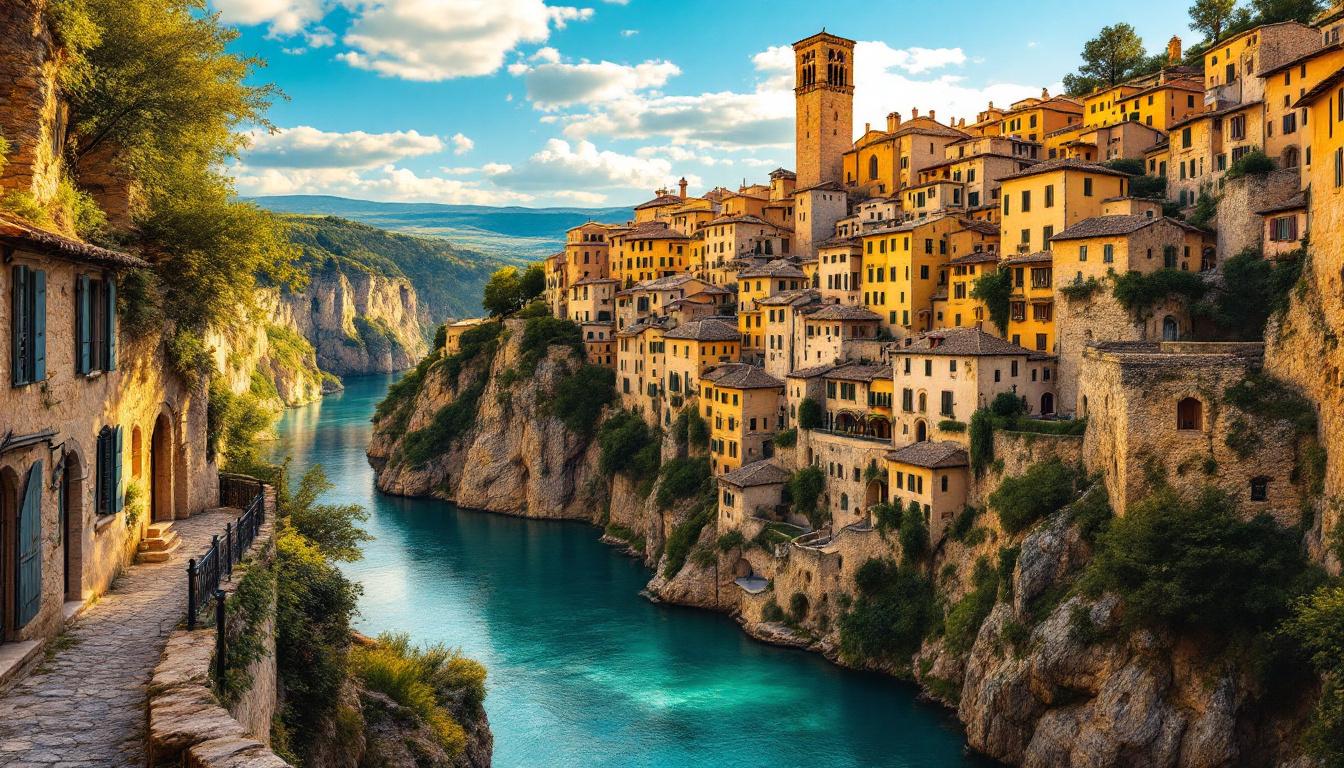Stepping through the medieval gates of Aiguèze, I felt transported five centuries back in time. This clifftop village in southern France hasn’t just preserved its medieval character—it lives it daily, exactly as Provence did in the 1500s.
While tourists flood commercialized destinations, 212 residents quietly guard secrets passed down through 800 years of continuous habitation. Every cobblestone, every vaulted passage, every sun-warmed limestone wall tells the authentic story of medieval France that mass tourism has erased elsewhere.
Perched 300 feet above the Ardèche River, Aiguèze remains what all of medieval Provence once was—untouched, unspoiled, and utterly authentic.
Medieval daily rhythms that never stopped
Thursday morning markets unchanged for centuries
Every Thursday morning, Aiguezois gather for market exactly as their ancestors did in the Middle Ages. Local producers spread regional cheeses, olive oils, and seasonal produce across ancient stone squares. The ritual hasn’t changed—only the faces have.
Evening boules beneath plane trees planted in 1847
At Place du Jeu de Paume, residents still gather for boules beneath towering plane trees. This medieval square echoes with laughter and friendly competition, maintaining social traditions that disappeared from modernized French villages decades ago. The game continues as sunset paints limestone walls honey-gold.
Five protected monuments guarding medieval secrets
Saracen tower revealing 8th-century fortress strategies
The village’s Saracen Tower stands sentinel exactly where medieval defenders positioned it against 8th-century invasions. Unlike reconstructed tourist attractions, this tower maintains its original defensive positioning, offering insights into authentic medieval military architecture that textbooks can’t teach.
Hidden vaulted passages locals call “Combe aux oiseaux”
Beneath village streets, Romanesque vaults connect medieval buildings through secret passages. Locals know every hidden entrance, every emergency exit their ancestors used. These aren’t tourist attractions—they’re living architectural heritage still serving the community as intended 500 years ago.
Artisan traditions surviving modern France
Stone masons maintaining 11th-century techniques
Village masons still repair buildings using traditional limestone quarrying methods and medieval mortar recipes. When restoration threatens historical integrity, they consult techniques passed down through family workshops operating since the Renaissance. Modern France has forgotten these skills—Aiguèze preserves them.
Community governance protecting cultural inheritance
Residents actively resist development pressures that destroyed authentic character elsewhere. Monseigneur Fuzet’s conservation efforts from the early 1900s established protective traditions locals maintain today, ensuring every renovation respects medieval architectural principles rather than modern convenience.
Natural protection preserving authentic atmosphere
Ardèche Gorges creating medieval isolation
Europe’s Little Grand Canyon naturally limits access exactly as medieval geography intended. Dramatic limestone cliffs plunging to emerald waters below create the same protective isolation that allowed medieval communities to develop distinct cultural identities without outside interference.
Seasonal rhythms unmarked by mass tourism
Unlike Provence’s tourist hotspots, Aiguèze maintains authentic seasonal patterns. Summer evening concerts echo through medieval squares without commercial amplification. Spring markets overflow with local abundance. Winter quiet allows contemplation exactly as medieval communities experienced centuries of natural cycles.
Visiting Aiguèze offers something increasingly rare—authentic medieval France without theatrical reconstruction or tourist manipulation. This isn’t a preserved museum village but a living community maintaining cultural continuity exactly as Provence existed before mass tourism changed everything forever.
The narrow cobbled streets, vaulted passages, and limestone facades aren’t historical curiosities—they’re home to families carrying forward traditions their ancestors established when France was truly medieval. Experience authentic French village life exactly as it was meant to be lived, protected by residents who understand their cultural inheritance too precious to commercialize.
Planning your authentic medieval discovery
When do locals recommend visiting Aiguèze?
Late spring through early autumn offers perfect weather for exploring medieval streets and hiking gorge trails. Locals suggest avoiding peak August crowds by visiting in May or September when village life maintains its authentic rhythm without seasonal tourist pressure.
How do you respect village traditions during your stay?
Residents appreciate visitors who understand Aiguèze isn’t a theme park but a living community. Shop at Thursday markets, greet locals politely, and avoid photographing private courtyards. Cultural sensitivity ensures this medieval treasure remains authentic for future generations.
What makes Aiguèze different from other medieval villages?
Unlike reconstructed tourist destinations, Aiguèze maintains continuous habitation since the Middle Ages. Buildings show organic evolution rather than artificial restoration, creating authentic atmosphere impossible to manufacture elsewhere in modern France.
